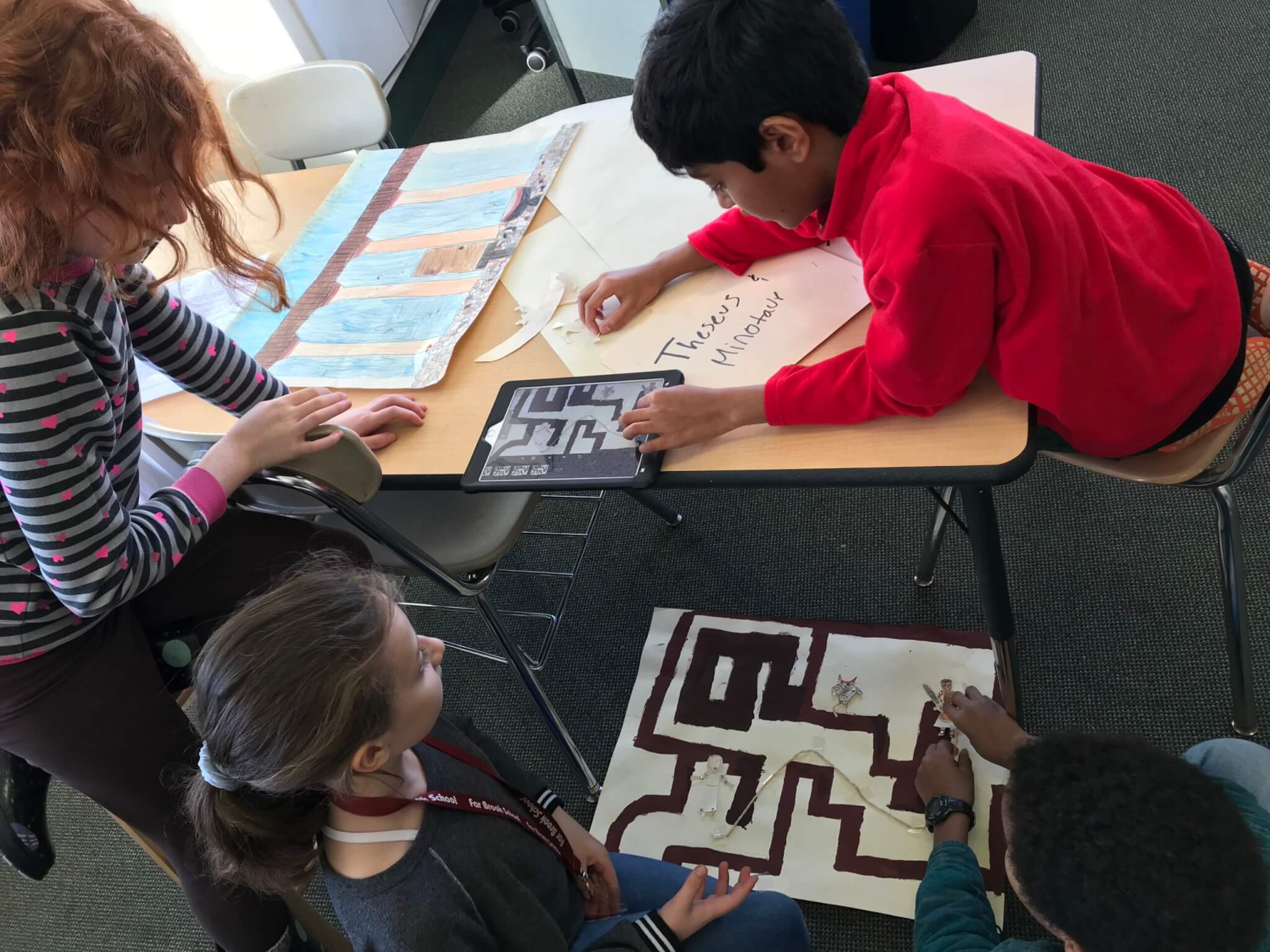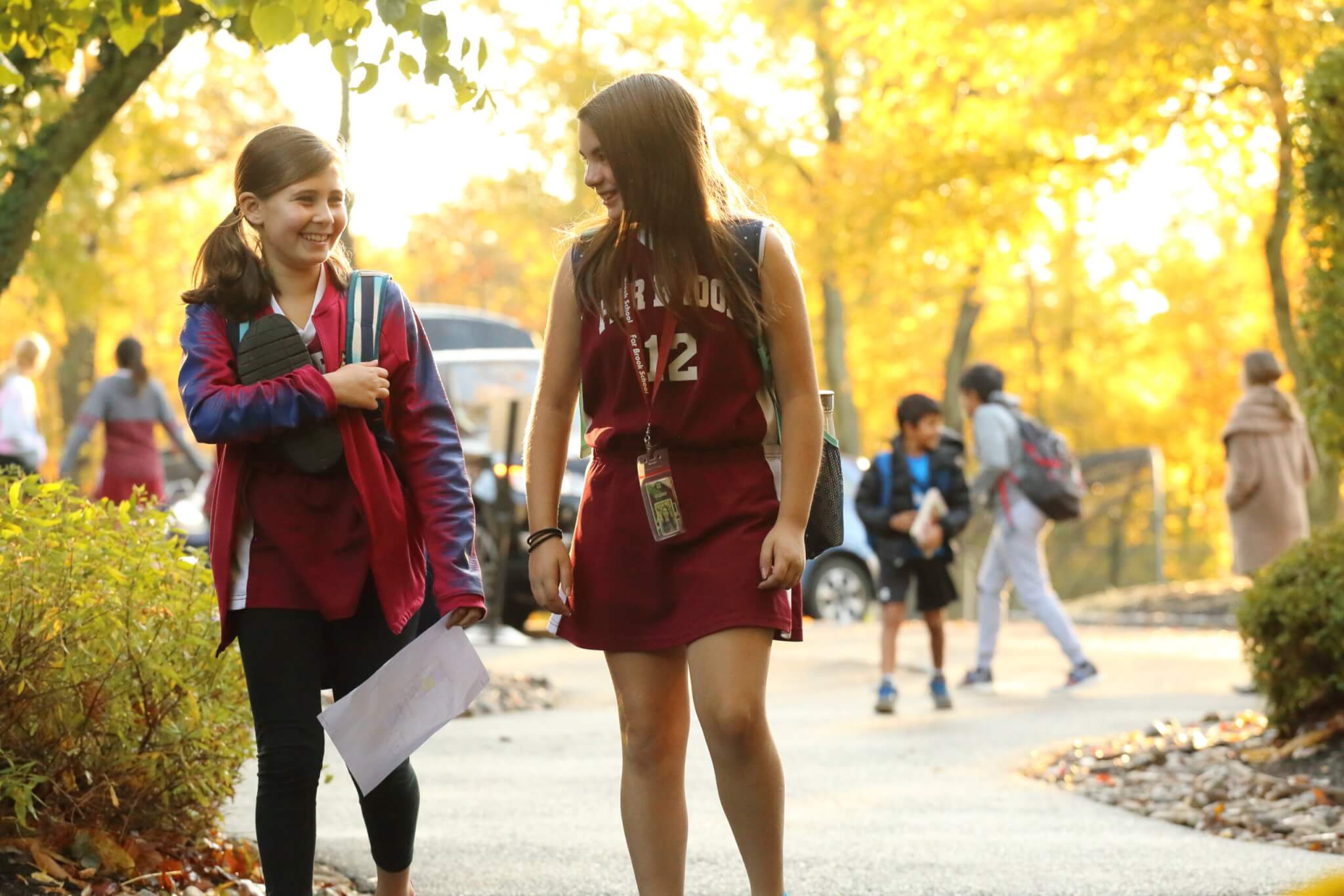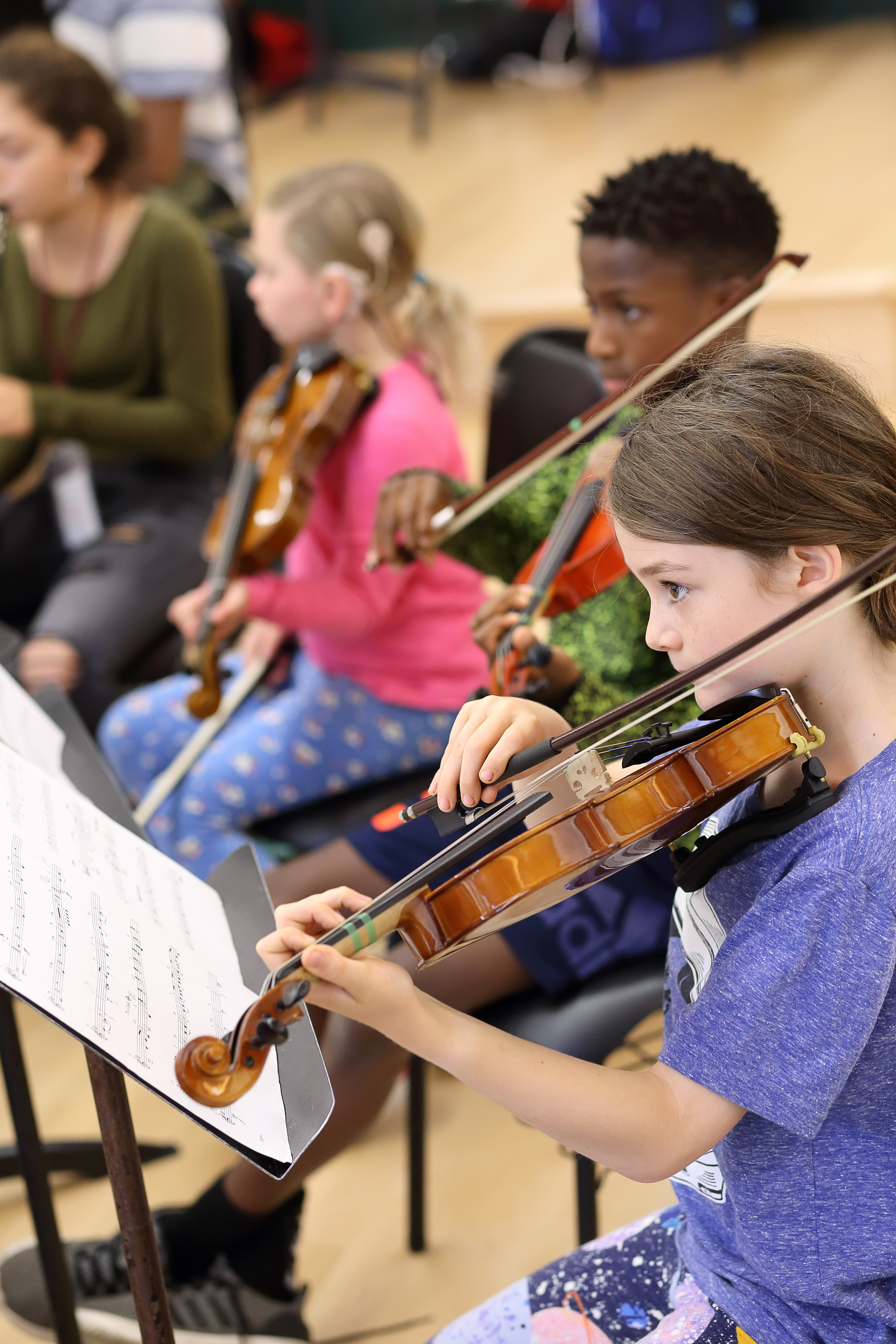Fifth Grade
Ancient East Asia: What Is Voice?
Core Curriculum
In the Fifth Grade at Far Brook, students explore the essential question: What is Voice? Using art as a lens for social studies and daily life, students explore the art of ancient East Asia in order to better understand ideas such as cultural diffusion, hierarchy, various belief systems and mythologies. Beginning with the development of ancient Chinese civilization, students will form a better understanding of the unique history and culture of East Asia.
East Asia is a complex make-up of cultures; China, Korea, Vietnam, and Japan are explored as students gain an understanding of the cultural connections and differences between countries and cultures that make up this diverse continent.
The class spends a considerable amount of time turning attention to the role of storytelling, mythology and religion in ancient China and comparatively throughout East Asia, including Korea, Vietnam and Japan; systems that allow for universal voice and connection. To gain a broader understanding of identity and the rich power of culture, students explore voice and storytelling from a mythological perspective, delving deeper into how cultures use symbolism in myths and poetry to reflect identity.
The class engages in lively discussions and learns to read for details and generate main ideas to support their conversations. They continue to develop the research skills learned in earlier years and use these to further their understanding of various research topics.
Literacy
Reading: The essential question, “what is voice?” also informs the reading and writing curriculum as students consider voice in both the texts they read and those they write. Fifth Graders build upon the reading strategies they learned in previous years. Now more comfortable with drawing inferences and writing in more detail about their thinking, students learn how to think more deeply about the characters, and to understand how paying close attention to the desires and motivation of these characters can deepen their understanding of a text. Students also focus on reading and analyzing nonfiction texts both to extract information and to better understand an author’s point of view. In Fifth Grade, students read independent books as well as books with a group of classmates.
Writing: In Fifth Grade, students continue to focus on narrative, information, and opinion writing, and poetry, using more sophisticated techniques and creating more detailed and fully developed pieces. Students learn strategies to improve the effectiveness of their writing during whole class instruction and then receive individual coaching to give immediate feedback as they learn to improve their skills. Students study how to create rising tension in a story, how to structure an essay with supporting details, how to revise their work, and how to organize an argument through effective use of paragraph structure. Spelling, vocabulary, and grammar skills are reinforced through Word Study lessons. Keyboarding skills continue to be refined and utilized. Drafting and editing of written work is done through word processing.
Math
The skills of problem solving, communication, critical thinking, and analysis continue to evolve in math in the Fifth Grade. Emphasis is placed on problem-solving processes and sound computation skills as students master the operations of addition, subtraction, multiplication, and division as applied to whole numbers, fractions, and decimals. Hands-on activities and math games deepen and enrich student understanding and application.
The Fifth Grade math curriculum includes all whole number and decimal operations; powers of ten; fraction comparison and fraction operations; coordinate geometry; classifying triangles and quadrilaterals; and perimeter, area, and volume of geometric shapes.
Text: Illustrative Math 5.
Science
The Fifth Grade science curriculum, “How Our Bodies Work: From Atoms to Systems,” is directly connected to the core curriculum study of Ancient Greece. Not only were the Ancient Greeks the first people to think about the idea of the atom, but they were also intrigued by the human figure. Students explore the human body, starting from the most basic level of the atoms that make up the body and progressing through how those atoms connect together to make more complex structures. The year begins with the foundations of chemistry, including an introduction to matter, the atom, and the Periodic Table of Elements. Students then build upon their knowledge of atoms and elements to better understand molecules, cells, tissues, organs, and organ systems. Specifically, students examine the following organ systems: nervous, skeletal, muscular, circulatory, respiratory, digestive, and reproductive. The Fifth Grade science course includes a unit on puberty, health, and the male and female reproductive systems.
Throughout the year, the students learn the fundamentals of scientific exploration by conducting lab experiments and completing hands-on projects. Students continue to build on their science practices by making predictions and hypotheses, recording data, analyzing and drawing conclusions from their data, and applying these conclusions to real world situations.
World Languages
The language program at the Fourth and Fifth Grade level allows each student to experience one semester of French and one semester of Spanish during the school year.
French and Spanish: In the Fifth Grade French and Spanish classes, students use storytelling techniques, guided reading, personalized conversation, songs, and communicative games to develop the four major skills: reading, writing, listening, and speaking. The class acquires phrases related to the classroom, parts of the body, and the family. Vocabulary, such as the calendar, numbers 0-50, greetings, classroom objects, and classroom commands are addressed on an ongoing basis as students learn to function in the classroom. Students create mini skits, and participate in interactive games and activities to deepen their understanding. Grammar concepts include differentiating between talking to one person compared to a group of people and recognizing plural and gender markers.
Performing Arts
Dance Choreography: The Dance choreography workshop builds on the skills and creative experiences the students have in Dance during their previous years. Students take inspiration both from their classroom learning and from instruction in dance to create their own movement in small groups that will be woven into the larger structure of group choreography.
Music Theory and Choir: All students in the Fourth and Fifth Grades participate in the Far Brook Choir and study sight-singing, theory, vocal tone development and choral part-singing. Students rehearse for the Thanksgiving Processional in the fall semester, studying repertoire focusing on the harvest, which they perform with the more advanced ensemble, Group. The Spring Concert provides an opportunity for the Choir to sing alone, without the assistance of the older students, in a formal concert setting exploring themed repertoire.
For students in the Fifth Grade, Choir continues to provide an opportunity to merge note-reading skills with the voice. Tracking words and notes on the musical score while continuing to learn to produce and support a beautiful singing tone and following a conductor remain a continued goal.
Orchestra: Students in Grades 4-8 join the Far Brook Orchestra once they reach a certain level of proficiency in their musical skills. The Orchestra plays in Morning Meeting and at the Spring Concert. Many students who participate in Orchestra also perform in the annual Recital Night in the spring.
Drama: Integrating the Fifth Grade study of medieval China, students engage with, and perform, classic tales of ancient legends told by a Chorus-based ensemble and drawn from major sources in classic Chinese culture, both theatrical and literary. Currently, episodes from the foundational epic The Journey to the West have been powerfully providing a vast canvas of medieval China for the students to contextualize and perform. Here, individuals begin to step out of the Chorus to draw out conflicts, and the students delve into more complex language and situations than they had dealt with previously. The Fifth Grade play facilitates the students’ transition to the investigation, rehearsal, and presentation of these dynamic, classic narratives of Chinese literature. At the same time, the production likewise gives them the opportunity to delve into a distant era and culture both actively and interactively, as a core part of their history curriculum. The play is shared with the Far Brook community in mid-winter.
Fine Arts
Art: While in art, Fifth Graders create their own original mosaic designs utilizing glass tiles. Students begin by designing their own personalized insignia on paper, focusing on the importance of layout and design, as well as the meaning of color and symbolism in art. Students continue to evolve their 2-dimensional ideas and finally realize them in 3-dimensional glass mosaic format. Students develop the basic and historical approaches and techniques to tile arrangement, which they incorporate into their original, hand-tiled mosaic insignia; a modern-day nod to a significant and ancient art form.
Woodshop and Design Thinking: In the Fifth Grade Woodshop mini, students design kinetic sculptures. Using cams, gears, and driveshafts, these sculptures are brought to life using hand tools as well as digital design tools. The combination of digital and physical tools allow students to fully explore their creativity. The students independently examine challenges as they arise and work collaboratively as they explore the trial and error process that is a natural part of original design. Woodshop projects at this level make use of all the tools that have been mastered over the span of the student’s time at Far Brook.
Technology
The Fifth Grade Technology Mini begins by engaging students in thoughtful discussions and activities about how to maintain media balance in their lives. Next, using their Typing.com accounts, students spend some class time checking in on their keyboarding skills (which they continue to work on throughout the school year). Following this check-in, Fifth Graders develop their understanding of physical computing by coding a microcontroller (a small computer), the BBC micro:bit. Initially, each Fifth Grader codes their own micro:bit; but, once each student has facility with the device, students code their micro:bits to play a series of games with their classmates that locally network the microcontrollers.
Social and Emotional
The Middle School years are exciting times as students move into the early stages of adolescence and take on increasing levels of responsibility for their learning and for their roles in Far Brook life. As the ability of the students to think abstractly and analytically, and with more critical discernment increases, teachers work to utilize and stretch these developing skills by challenging students to work in greater depth and scope.
In Middle School, the Learning Specialist works with students individually and in small groups within various classroom settings. The learning specialist consults regularly with the classroom teachers to coordinate strategies that take into account students’ specific learning styles.
Students in the Middle School begin to take on more responsibility for their learning. Through support from their academic teachers and the Learning Specialist, students learn organization and time management skills that are reinforced daily, resulting in students who are more independent with homework. Students also learn various study strategies as they prepare for quizzes and tests and memorize lines for their class play. In addition, students learn test-taking techniques for classroom quizzes and tests, and are also afforded opportunities to experience standardized testing. The ERB CTP-5 is administered to the Fifth through Eighth Grade students each year.
Community Groups: In the Fifth and Sixth Grades, Community groups provide an opportunity for small group conversations across the grade levels. Discussions focus on identity, community and a broad range of social justice topics. Students engage in conversations about what community means and what it means to be active and engaged community members. In their small groups, students design and take ownership of a service learning project and a Far Brook community project. Both as an individual and a collective group, students recognize they have influence as helpers and leaders in their class, the Middle School, the Far Brook community, and beyond.
Classroom Meetings: Fifth Graders have weekly class meetings to participate in discussions that help them assess their progress as a class community. During these meetings the teachers, school counselor or Director of Diversity, Equity, and Community lead lessons on topics such as establishing and respecting community expectations, cooperating and compromising, problem-solving, recognizing and accepting differences among people, mindfulness, positive self-talk, and more. The goals of these lessons and meetings are to create a cooperative classroom environment and to give students the skills they need to solve interpersonal problems and to build positive relationships.
Middle School Project Day: Each spring, students in Grades 4-6 have a special day to choose, explore, and share arts and interests that are outside of their usual curriculum. Recent projects have included tie-dying fabrics, making world cuisines, creating wood-burned designs, and performing original skits.
Fairview Lakes: In September Grades 5 and 6 travel to Fairview Lakes for a full day of nature exploration and fun team building exercises.
Sports and Wellness
Sports: The Fifth Grade Sports program includes a combination of cooperative team-building activities, and fitness and strength development. Fall sports offerings are soccer, field hockey, and cross country. In the spring, baseball, lacrosse, and track & field are offered. Students continue to learn the rules and strategies of these sports, and practice more advanced skills, leading to active participation in interscholastic competition. The development of leadership abilities and learning to be a supportive teammate are reinforced during every practice and game. The cornerstone of the sports curriculum is character development through sportsmanship. It is essential that our students learn what it means to be a positive and reliable member of a team, and how to handle the adversity of competition. During the sports seasons, students share Sports Reports in Morning Meeting, reporting on the team’s accomplishments to the entire school community. When not in season, the students participate in activities such as pickleball, ultimate frisbee, team handball, basketball and various fitness activities.
Health & Wellness: During the winter session, students participate in sports games, fitness training, and health classes. At the Fifth Grade level students complete the first half of the American Red Cross First Aid Babysitting Curriculum. Topics covered include leadership, child safety, and emergency care. This class continues into the Sixth Grade year and includes an American Red Cross certification at the end of the course.
After School Programs
Interscholastic Sports Teams— Students at the Fifth Grade level compete for the first time on the Far Brook Interscholastic sports teams. All students in Grades 5-8 participate on these teams. Fifth Graders are mentored by the Sixth Graders during practices and game play. Practices are held during the school day, four times a week, while the interscholastic games occur during after school hours.
After School Classes— Many families use school services beyond the school day. At Far Brook we offer fee-based programs that provide enrichment, variety, and opportunities for students from multiple grades to connect and interact.
Students can sign up for a variety of classes that are offered every day of the week. Some of our classes are also available on a drop-in basis so that families may periodically enroll when the need arises.
Class offerings may include: Chess, Sports and Games, Soccer Skills, Culinary Arts, Classic Crafts, Technology, Flag Football, STEAM, and Homework Club.



View Curriculum Guide in ISSUU
